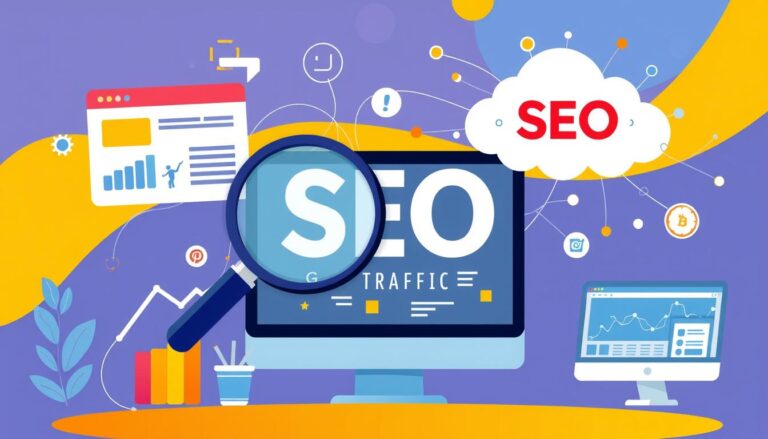E-commerce SEO Strategies to Boost Sales
In today’s digital world, e-commerce SEO is key for online businesses to grow. It’s not just about listing products. It’s about making your brand easy to find and connect with through search engine marketing.
Ruggable shows how powerful organic traffic can be. They get over a million visitors a month. This beats paid ads by a huge margin, showing SEO can boost sales without spending a lot.
Your store’s success depends on finding the right search strategies. It’s about reaching customers when they’re ready to buy. Good SEO is about making real connections, not just ranking high.
Table of Contents
Understanding the Fundamentals of E-commerce SEO
E-commerce success relies on smart search engine optimization. Google is behind 43% of online shopping visits. Knowing how to optimize product pages is key for online stores. Your store’s visibility affects sales and how engaged customers are.

Digital marketers see e-commerce SEO as different from regular website optimization. It needs special strategies for specific shopping behaviors and search patterns.
What Makes E-commerce SEO Unique
- Focuses on product-specific keyword optimization
- Emphasizes conversion rate optimization
- Addresses shopping cart abandonment challenges
- Requires dynamic content strategies
Search Engines’ Role in Online Shopping
Search engines are key for shoppers. 35% of product searches lead to purchases within five days. This shows how vital digital visibility is.
| SEO Performance Metric | Impact Percentage |
|---|---|
| Organic Search Click Rate | 39.8% |
| Conversion Potential with Reviews | 52.2% |
| Marketing Channel ROI | 49% |
Key E-commerce Optimization Components
- Comprehensive keyword research
- Enhanced product page descriptions
- Technical site performance optimization
- User experience improvements
“SEO is not about gaming the system, but about creating an exceptional user experience that search engines reward.”
Getting good at e-commerce SEO means always learning and updating your strategy. Your digital plan must keep up with changing consumer habits and search engine rules.
Performing Comprehensive Keyword Research
Keyword research is key to a good e-commerce SEO strategy. It helps you find out what your potential customers search for online.

Good keyword research means knowing the search terms that bring people to your site. This includes:
- Long-tail keywords with specific product details
- Commercial intent keywords
- Branded search terms
- Seasonal variation keywords
“The right keywords are your gateway to connecting with motivated buyers.” – Digital Marketing Experts
When you do keyword research, look at search volume and competition. Tools like Google Keyword Planner, SEMrush, and Ahrefs can give you useful info.
| Keyword Type | Search Volume | Competition Level |
|---|---|---|
| Short-tail keywords | High (10,000+ monthly) | Very competitive |
| Long-tail keywords | Low-Medium (100-1,000) | Low competition |
| Branded keywords | Varies | Moderate |
By doing strategic keyword research, you can see what users want. This helps you reach the right people and bring more traffic to your site.
Optimizing Product Pages for Maximum Visibility
Your e-commerce success depends on powerful product pages. These pages must attract both search engines and potential customers. With about 32% of online purchases starting on Google, optimizing your pages can greatly increase visibility and sales.
Effective product page optimization involves several key strategies. These strategies turn casual browsers into committed buyers.
Writing Compelling Product Descriptions
Product descriptions are like digital sales reps. They should mix strategic keywords with engaging stories. This can greatly influence buying decisions. Here are some important tips:
- Use unique descriptions for each product to avoid duplicate content
- Incorporate transactional and commercial intent keywords naturally
- Highlight specific product benefits and features
- Include long-tail keywords for targeted search visibility
Optimizing Product Images and Videos
Visual content is key in online shopping. Research shows 50% of shoppers use images to decide. To optimize your visuals, consider the following:
- Use high-resolution, clear product images
- Add descriptive alt text with relevant keywords
- Compress images to keep page load speed fast
- Create engaging product videos
Implementing Schema Markup
Schema markup helps search engines understand your product details. This can increase click-through rates. By adding structured data, you offer rich snippets that make your listings more appealing in search results.
| Schema Markup Element | SEO Impact |
|---|---|
| Product Name | Increases search relevance |
| Price | Attracts price-conscious shoppers |
| Availability | Provides immediate product status |
| Reviews | Builds trust and credibility |
“In the world of e-commerce, your product page is your digital storefront. Make every element count.” – E-commerce SEO Expert
By using these strategies, you’ll make your product pages rank higher and convert better. This will drive sustainable growth for your online business.
Enhancing Site Architecture and Navigation
Creating a good site structure is key for your e-commerce success. Your website’s architecture is like a map for users and search engines. A good navigation system boosts user experience and search rankings.
- Use a flat site architecture so users can find any page in three clicks
- Make category hierarchies that make sense to your visitors
- Design menus that group related products well
“A well-structured website is like a well-organized store – it helps customers find exactly what they want quickly and easily.” – Barnabas Helmy, SmashToast, Inc.
Internal linking is vital for site structure. It helps search engines understand your site and makes navigation smooth for users.
| Navigation Strategy | SEO Impact | User Experience Benefit |
|---|---|---|
| Logical Category Grouping | Improved Crawlability | Easier Product Discovery |
| Clear URL Structure | Better Search Rankings | Simplified Navigation |
| Comprehensive Internal Linking | Enhanced Page Authority | Increased Engagement |
Your site’s architecture should be easy to change and grow. Always check and improve your navigation to meet user and search engine needs.
Creating High-Converting Category Pages
Category page optimization is key for e-commerce sites to boost traffic and user experience. Your category pages are crucial entry points for potential customers. They act as navigational hubs, guiding shoppers through your products.
Good category page design is more than just listing products. It needs a strategic approach that meets user and search engine needs.
Category Page Structure Best Practices
Creating an intuitive category page involves several key elements:
- Create clear, descriptive headings
- Include informative category descriptions
- Organize products logically
- Use high-quality product images
Implementing Effective Filtering Systems
Robust filtering systems help users find products fast. Consider adding these filtering options:
| Filter Type | User Benefit |
|---|---|
| Price Range | Budget-conscious shopping |
| Size/Color | Precise product selection |
| Customer Ratings | Quality assessment |
Optimizing Category Meta Data
Meta data is vital for search engine visibility. Focus on creating:
- Descriptive title tags
- Compelling meta descriptions
- Relevant keywords
“A well-optimized category page can increase organic traffic by up to 30%” – E-commerce SEO Experts
By using these strategies, you’ll make category pages that attract search engines and offer a great user experience. This will drive more conversions.
Building Quality Backlinks for E-commerce Success
Link building is key for boosting your e-commerce site’s authority and rankings. Good backlink strategies can greatly increase your site’s visibility and bring more visitors to your store.
Focus on quality over quantity in link building. Search engines value high-quality, relevant backlinks. These show your site’s credibility and expertise in e-commerce.
“Backlinks are the currency of online reputation in digital marketing.” – SEO Experts
Proven Link Building Strategies for E-commerce
- Create compelling, original content that naturally attracts backlinks
- Develop industry research and data-driven reports
- Engage in strategic guest blogging
- Collaborate with industry influencers
- Leverage unlinked brand mentions
Knowing about domain authority is key for link building success. Sites with higher authority scores get more credible backlinks and rank better in search engines.
| Backlink Strategy | Impact on SEO | Difficulty Level |
|---|---|---|
| Original Research Content | High | Medium |
| Guest Blogging | Medium | Low |
| Influencer Collaboration | High | High |
Your link building should be steady and smart. Avoid sudden spikes in backlink acquisition, as this can trigger search engine suspicions of manipulation. Aim for real, relevant connections in your field.
Using these link building methods can boost your e-commerce site’s online presence. It will drive more targeted traffic and improve your search engine rankings.
Implementing Technical SEO Best Practices
Technical SEO is key for a successful e-commerce site. Your site’s performance relies on important technical aspects. These impact search rankings and user experience. Focus on site speed, mobile optimization, and URL structure to build a strong online store.
Now, let’s explore the main technical SEO strategies for your e-commerce site:
Site Speed Optimization
Site speed is crucial for search rankings and user happiness. Slow sites can lose customers. Here are some tips to speed up your site:
- Compress images to reduce file sizes
- Minimize JavaScript and CSS code
- Leverage browser caching
- Use content delivery networks (CDNs)
“A one-second delay in page load time can result in a 7% reduction in conversions.” – Google Research
Mobile Responsiveness
With 50% of shoppers aged 30-49 buying on smartphones weekly, mobile optimization is essential. Your site must work well on all devices.
- Use responsive design
- Optimize touch elements
- Ensure readable fonts
- Simplify navigation for mobile users
URL Structure and Canonical Tags
A clear URL structure helps search engines understand your site’s layout. Canonical tags prevent duplicate content by showing the preferred page version.
- Create descriptive, keyword-rich URLs
- Use hyphens to separate words
- Implement canonical tags for similar pages
- Keep URLs short and meaningful
By following these technical SEO best practices, you’ll boost your e-commerce site’s visibility and user experience. This can lead to better search rankings.
Leveraging Content Marketing for SEO Growth
Content marketing is a key strategy for e-commerce sites to increase their online presence. It helps attract potential customers and build your brand’s authority. By making valuable content, you can draw in more visitors and show your expertise.
Your content marketing should solve customer problems. Create different types of content for each stage of the buyer’s journey:
- Informational blog posts on product topics
- Comprehensive buying guides
- How-to tutorials and product demos
- Customer success stories and case studies
“Content marketing isn’t about creating massive amounts of content, but creating meaningful connections with your audience.”
Strategic blogging can greatly improve your SEO. Studies show that regular, high-quality content boosts organic traffic. In fact, 53% of all internet traffic comes from organic search, showing the need for a strong content plan.
When planning your content marketing, focus on these metrics:
- Engagement rates
- Time spent on site
- Conversion rates
- Social media shares
Use tools like Ahrefs and SEMrush to find the right keywords and understand search intent. Make sure your content ranks well and offers real value to your audience.
Content marketing costs can range from $5,000 to $20,000 a month. This covers strategy, writing, optimization, and production. Although it’s a big investment, the long-term benefits are worth it.
Managing E-commerce Analytics and Tracking
Tracking your online store’s performance is key for growth. E-commerce analytics give deep insights into your business. They help you make smart decisions to boost sales and enhance customer experience.
Successful online businesses use advanced analytics tools. They understand their market and improve their performance. Almost half of marketers find organic search the most profitable channel, making tracking crucial.
Key Performance Indicators (KPIs)
E-commerce analytics rely on important KPIs. These show your store’s health and growth areas. They help you see how your business is doing in different ways.
- Conversion rates
- Organic traffic volume
- Revenue from search channels
- Customer acquisition cost
- Average order value
Conversion Rate Optimization
Boosting conversion rates needs strategic analysis of user behavior. With over 70% cart abandonment, knowing where people drop off is key for success.
| Metric | Benchmark | Action Item |
|---|---|---|
| Cart Abandonment | 70% | Simplify checkout process |
| Mobile Research | 60% | Optimize mobile experience |
| Organic Traffic | 33% | Enhance SEO strategies |
Traffic Analysis Tools
Tools like Google Analytics and Google Search Console give deep insights. They track organic visibility, keyword rankings, and user behavior.
“Data is the new oil of the digital economy.” – Unknown
By always watching and understanding your e-commerce analytics, you can better your marketing. Improve user experience and drive growth in a competitive online world.
Optimizing for Voice Search and Mobile Commerce
The digital world is changing fast. Voice search and mobile commerce are now key for online stores. E-commerce sites need to focus on voice search to reach more mobile and voice shoppers.
Voice search is changing how we shop online. Here are some important facts:
- 71% of consumers prefer voice search over typing
- 51% use voice search for product research before buying
- By 2024, voice search is expected to drive over $40 billion in sales
To succeed in mobile commerce and voice search, you need a good plan. Use natural language and long-tail keywords that sound like how we talk.
“Voice search is not just a trend – it’s the future of digital interaction and e-commerce.”
Here are key strategies for voice search optimization:
- Create content that answers user questions
- Use structured data and schema markup
- Optimize for local SEO with location-specific keywords
- Make sure your site works well on mobile and loads fast
| Voice Search Optimization Metric | Recommended Target |
|---|---|
| Content Answer Length | 40-60 words |
| Server Response Time | Under 200ms |
| Mobile Traffic | Over 50% |
Use these tips to make your e-commerce site more visible. This will help you grab a bigger share of the voice search and mobile commerce market.
Implementing Local SEO for E-commerce Businesses
Local SEO is key for e-commerce businesses wanting to reach local customers. With almost 46% of Google searches looking for local info, making your online presence strong can really help. It boosts your visibility and brings in more foot traffic.
“Local search is no longer optional – it’s essential for modern e-commerce success.”
To be a top player in local SEO, focus on these important strategies:
- Optimize your Google My Business listing with accurate info
- Create pages just for your location
- Use local keywords that fit your business
- Manage and encourage online reviews from customers
Google looks at three main things for local search results: relevance, distance, and prominence. By getting these right, you can see a big jump in your local search rankings.
| Local SEO Strategy | Impact |
|---|---|
| Google My Business Optimization | 86% increase in location searches |
| Customer Review Management | 88% trust in online reviews |
| Location-Specific Keywords | 50% of “near me” searches lead to store visits |
Local SEO is not just about being seen. It’s about connecting with people in your area. By using these strategies, you’ll not only rank better in searches. You’ll also build real connections that help your business grow.
Conclusion
Your e-commerce SEO strategy is key to growing online sales. With global ecommerce sales set to hit $6.4 trillion by 2025, a strong digital marketing plan is a must. Focus on good keyword research, technical optimization, and quality content to boost your website’s traffic.
The digital world is all about precision. Over 75% of users don’t look beyond the first page of search results. So, making sure your site ranks high is crucial. Work on technical performance, user experience, and content that speaks to your audience.
Brands like Amazon and Zalando show how effective SEO can bring in millions of visitors and boost sales. As voice search and mobile shopping grow, staying flexible is vital. By 2025, voice searches will make up 50% of online queries, and Google will judge sites based on mobile-friendliness.
Keep improving your SEO, use long-tail keywords, and make your site easy to use on mobile. This will turn visitors into loyal customers.







